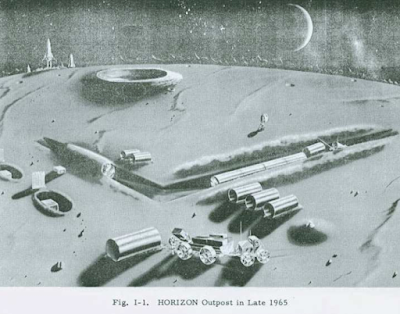Project Horizon was a classified military study undertaken by the United States Army in 1959. Its goal was to evaluate the feasibility of establishing a manned lunar outpost to extend U.S. military and scientific capabilities during the early stages of the space race with the Soviet Union. This ambitious proposal reflects the geopolitical tensions of the Cold War and the emerging emphasis on space as a strategic frontier.
Objectives of Project Horizon
The primary objectives of Project Horizon were:
- Establishing U.S. Presence on the Moon: The project aimed to create a manned lunar outpost by 1966 to assert dominance in space and prevent Soviet influence on the Moon.
- Military Operations: The lunar base was envisioned as a strategic asset, capable of supporting military operations, including surveillance and the potential use of space as a platform for missile systems.
- Scientific Exploration: In addition to military goals, the project included plans for scientific research, such as studying lunar geology, testing new technologies, and monitoring Earth from the Moon.
Proposed Implementation
The Army's report outlined a step-by-step approach:
- Phase 1: Initial Launches: The plan called for using Saturn-class rockets to transport equipment and supplies to the Moon.
- Phase 2: Lunar Base Construction: After landing construction materials, a team of astronauts would build an underground lunar station, shielding inhabitants from radiation and temperature extremes.
- Phase 3: Sustained Operations: The outpost would support a crew of up to 12 personnel, relying on regular resupply missions and eventually aiming for partial self-sufficiency.
Technical Challenges
The project faced significant technical challenges, including:
- Developing heavy-lift rockets capable of transporting substantial payloads to the Moon.
- Ensuring safe transportation and construction methods in a harsh, low-gravity, and airless environment.
- Creating life-support systems to sustain human life over long periods on the Moon.
Political and Budgetary Constraints
Despite its ambitious goals, Project Horizon never moved beyond the conceptual stage. The high estimated cost, combined with technical uncertainties and political factors, led to its cancellation. In particular, President Dwight D. Eisenhower’s administration was hesitant to commit vast resources to military-led space exploration, favoring civilian leadership through NASA.
Legacy
Although Project Horizon was shelved, it helped shape subsequent U.S. space policies and programs. Its focus on lunar exploration and heavy-lift launch vehicles influenced NASA’s Apollo program, which successfully landed astronauts on the Moon in 1969. The study also highlighted the interplay between military and civilian priorities in space exploration during the early space race.
In hindsight, Project Horizon represents a fascinating "what if" scenario, offering insight into Cold War-era thinking about the strategic importance of space and the Moon.

No comments:
Post a Comment